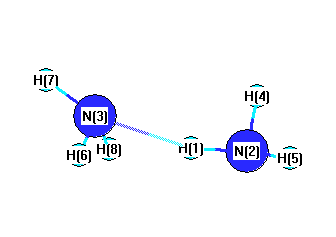Vibrational Frequencies calculated at B3LYP/6-31G**
| Mode Number |
Symmetry |
Frequency
(cm-1) |
Scaled Frequency
(cm-1) |
IR Intensities
(km mol-1) |
Raman Act
(Å4/u) |
Dep P |
Dep U |
|---|
| 1 |
Ag |
3580 |
3440 |
0.00 |
|
|
|
| 2 |
Ag |
3452 |
3317 |
0.00 |
|
|
|
| 3 |
Ag |
1700 |
1634 |
0.00 |
|
|
|
| 4 |
Ag |
1124 |
1080 |
0.00 |
|
|
|
| 5 |
Ag |
483 |
464 |
0.00 |
|
|
|
| 6 |
Ag |
157 |
151 |
0.00 |
|
|
|
| 7 |
Au |
3593 |
3452 |
0.16 |
|
|
|
| 8 |
Au |
1717 |
1649 |
25.69 |
|
|
|
| 9 |
Au |
258 |
248 |
110.85 |
|
|
|
| 10 |
Au |
108 |
104 |
30.20 |
|
|
|
| 11 |
Bg |
3593 |
3452 |
0.00 |
|
|
|
| 12 |
Bg |
1705 |
1638 |
0.00 |
|
|
|
| 13 |
Bg |
146 |
140 |
0.00 |
|
|
|
| 14 |
Bu |
3580 |
3440 |
22.47 |
|
|
|
| 15 |
Bu |
3455 |
3319 |
31.09 |
|
|
|
| 16 |
Bu |
1672 |
1607 |
13.09 |
|
|
|
| 17 |
Bu |
1101 |
1058 |
330.43 |
|
|
|
| 18 |
Bu |
97 |
94 |
311.98 |
|
|
|
Unscaled Zero Point Vibrational Energy (zpe) 15760.7 cm
-1
Scaled (by 0.9608) Zero Point Vibrational Energy (zpe) 15142.9 cm
-1
See section
III.C.1 List or set vibrational scaling factors
to change the scale factors used here.
See section
III.C.2
Calculate a vibrational scaling factor for a given set of molecules
to determine the least squares best scaling factor.
Charges, Dipole, Quadrupole and Polarizability
Charges from optimized geometry at B3LYP/6-31G**
Charges (e)
| Number |
Element |
Mulliken |
CHELPG |
AIM |
ESP |
| 1 |
H |
0.266 |
|
|
|
| 2 |
N |
-0.741 |
|
|
|
| 3 |
N |
-0.741 |
|
|
|
| 4 |
H |
0.238 |
|
|
|
| 5 |
H |
0.238 |
|
|
|
| 6 |
H |
0.266 |
|
|
|
| 7 |
H |
0.238 |
|
|
|
| 8 |
H |
0.238 |
|
|
|
Electric dipole moments
Electric dipole components in Debye
(What's a Debye? See section
VII.A.3)
| |
x |
y |
z |
Total |
| |
0.000 |
0.000 |
0.000 |
0.000 |
| CHELPG |
|
|
|
|
| AIM |
|
|
|
|
| ESP |
|
|
|
|
Electric Quadrupole moment
Quadrupole components in D Å
| Primitive |
|---|
| | x | y | z |
|---|
| x |
-16.215 |
4.197 |
0.000 |
| y |
4.197 |
-9.274 |
0.000 |
| z |
0.000 |
0.000 |
-12.332 |
|
| Traceless |
|---|
| | x | y | z |
|---|
| x |
-5.412 |
4.197 |
0.000 |
| y |
4.197 |
4.999 |
0.000 |
| z |
0.000 |
0.000 |
0.412 |
|
| Polar |
|---|
| 3z2-r2 | 0.824 |
|---|
| x2-y2 | -6.941 |
|---|
| xy | 4.197 |
|---|
| xz | 0.000 |
|---|
| yz | 0.000 |
|---|
|
Polarizabilities
Components of the polarizability tensor.
Units are
Å
3 (Angstrom cubed)
Change units.
| |
x |
y |
z |
| x |
1.878 |
-0.017 |
0.000 |
| y |
-0.017 |
3.577 |
0.000 |
| z |
0.000 |
0.000 |
2.840 |
<r2> (average value of r
2) Å
2
| <r2> |
64.488 |
| (<r2>)1/2 |
8.030 |
